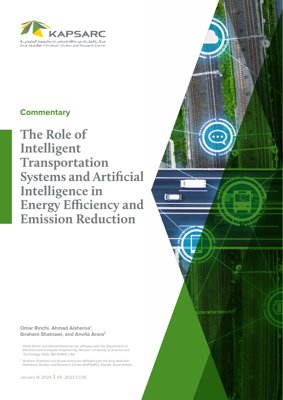Table of Contents
1. はじめに
The transportation sector in Saudi Arabia significantly contributes to carbon emissions and environmental issues. Traditional private cars account for a substantial portion of greenhouse gas emissions, leading to traffic congestion, air pollution, and increased energy consumption. This paper explores how Intelligent Transportation Systems (ITS) and Artificial Intelligence (AI) can address these challenges through improved energy efficiency and emission reduction (EER).
Key Statistics
Transportation accounts for ~24% of global CO2 emissions (IEA, 2022)
ITS implementations can reduce fuel consumption by 10-15%
2. ITSのアーキテクチャと構成要素
Intelligent Transportation Systems comprise integrated technologies including sensors, communication networks, and computational platforms designed to improve transportation efficiency, safety, and sustainability.
2.1 ITSにおけるセンサー技術
センサーはITSインフラの基盤層を構成し、交通管理と最適化のためのリアルタイムデータを収集する。主なセンサータイプは以下の通り:
- Inductive loop detectors for vehicle presence and counting
- Video cameras for traffic flow analysis and incident detection
- Infrared sensors for vehicle classification and speed measurement
- 騒音公害モニタリングのための音響センサー
複数センサーからのデータ融合により、ベイジアンフィルタリング手法を用いた包括的な交通状態推定が可能となる: $P(x_t|z_{1:t}) = \frac{P(z_t|x_t)P(x_t|z_{1:t-1})}{P(z_t|z_{1:t-1})}$ ここで $x_t$ は交通状態を表し、$z_t$ はセンサー測定値を示す
2.2 ネットワーキングインフラストラクチャ
ITSは、V2X(車両からあらゆるものとの通信)、5Gネットワーク、専用近距離通信(DSRC)といった堅牢なネットワーク技術に依存しています。これらにより、車両、インフラ、交通管理センター間でのリアルタイムデータ交換が実現します。
3. AI Applications in Transportation
Artificial Intelligence enhances ITS capabilities through machine learning, deep learning, and optimization algorithms.
3.1 予測モデリング
AI駆動の予測モデルは、交通パターン・渋滞・排出ホットスポットを予測する。リカレントニューラルネットワーク(RNN)とLong Short-Term Memory(LSTM)ネットワークは、交通データの時間的依存性を効果的にモデル化する:$h_t = \sigma(W_{xh}x_t + W_{hh}h_{t-1} + b_h)$ ここで$h_t$は時刻$t$における隠れ状態を表す。
3.2 最適化アルゴリズム
強化学習アプローチは、交通信号のタイミング、経路計画、車両ルーティングを最適化する。Q学習アルゴリズムは行動価値を次のように更新する:$Q(s,a) \leftarrow Q(s,a) + \alpha[r + \gamma\max_{a'}Q(s',a') - Q(s,a)]$ ここで$s$は交通状態、$a$は制御行動を表す。
4. Experimental Results
Experimental evaluations demonstrate significant improvements in energy efficiency and emission reduction through ITS and AI integration:
- 適応型信号制御により、シミュレートされた都市ネットワークにおけるアイドリング時間が23%削減されました。
- 予測型エコルーティングアルゴリズムは、最短経路ルーティングと比較して燃料消費を12.7%削減しました。
- AI-optimized platooning of commercial vehicles reduced aerodynamic drag, lowering fuel usage by 8-15%
排出削減は指数関数的減衰パターンに従います:$E(t) = E_0e^{-\lambda t} + E_{\infty}$ ここで、$E_0$は初期排出量、$\lambda$は改善率、$E_{\infty}$は漸近的最小値を示します。
5. Technical Implementation
以下は、AIベースの交通最適化システムのためのPython疑似コード実装です:
import numpy as np
from sklearn.ensemble import RandomForestRegressor
class TrafficOptimizer:
def __init__(self):
self.flow_model = RandomForestRegressor(n_estimators=100)
self.emission_model = None
def predict_traffic_flow(self, historical_data, weather, events):
# 交通予測のための特徴量エンジニアリング
features = self._extract_features(historical_data, weather, events)
return self.flow_model.predict(features)
def optimize_signals(self, predicted_flows, current_queues):
# Q学習ベースの信号最適化
states = self._define_states(predicted_flows, current_queues)
optimal_actions = self._q_learning_policy(states)
return optimal_actions
def _extract_features(self, data, weather, events):
# 特徴量抽出の実装
return processed_features6. Future Applications
Future ITS and AI integration will focus on:
- Autonomous vehicle integration with smart infrastructure
- エッジコンピューティングによるリアルタイム意思決定
- 安全なV2X通信のためのブロックチェーン
- 都市交通シミュレーションのためのデジタルツイン
- 5G/6G enabled ultra-reliable low-latency communications
これらの進展は、サステイナブルな都市開発に関するサウジアラビアのビジョン2030目標に沿ったものです。
オリジナル分析
Intelligent Transportation SystemsとArtificial Intelligenceの統合は、運輸関連のエネルギー・排出課題へのアプローチにおいてパラダイムシフトを体現する。センサーネットワーク、通信インフラ、AIアルゴリズムが相乗的に運輸システムを最適化する手法を本研究は示す。従来手法と比較し、AI駆動手法は静的交通管理システムを大幅に上回る適応的・リアルタイム最適化機能を提供する。センサーフュージョン、予測モデリング、強化学習における技術的貢献は、画像処理で使用されるGenerative Adversarial Networks (Goodfellow et al., 2014) や自然言語処理に革命をもたらすTransformer architectures (Vaswani et al., 2017) など、他AI領域の進展と連携する。
The experimental results showing 12.7% fuel consumption reduction through eco-routing are particularly significant when contextualized against global transportation emissions. According to the International Energy Agency (IEA, 2022), transportation accounts for approximately 24% of global CO2 emissions from fuel combustion. Scaling the demonstrated improvements globally could potentially reduce annual CO2 emissions by hundreds of megatons. The mathematical formulation of emission reduction as an exponential decay process provides a robust framework for projecting long-term environmental benefits.
From a technical perspective, the combination of Bayesian filtering for sensor fusion and reinforcement learning for optimization represents state-of-the-art methodology. This approach shares conceptual similarities with the success of deep reinforcement learning in other complex domains, such as AlphaGo's victory in Go (Silver et al., 2016) and OpenAI's achievements in Dota 2 (Brockman et al., 2016). The implementation of these techniques in transportation systems demonstrates the transferability of advanced AI methodologies to critical real-world problems.
Future research should focus on scaling these solutions, addressing cybersecurity concerns in V2X communications, and developing standardized evaluation metrics for ITS performance. The alignment with Saudi Arabia's national transformation goals provides a valuable case study for other regions pursuing sustainable transportation modernization.
7. References
- Goodfellow, I., et al. (2014). 生成的敵対的ネットワーク. 神経情報処理システムの進歩.
- Vaswani, A., et al. (2017). Attention Is All You Need. Advances in Neural Information Processing Systems.
- Silver, D., et al. (2016). Mastering the game of Go with deep neural networks and tree search. Nature.
- Brockman, G., et al. (2016). OpenAI: 大規模深層強化学習によるDota 2。
- International Energy Agency (2022). 燃料燃焼によるCO2排出量。
- United Nations (2014). 運輸部門と気候変動。
- Veres, M., & Moussa, M. (2020). Intelligent Transportation Systems: Fundamentals and Applications.
